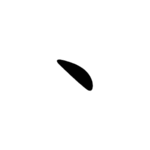| 丶 | ||
|---|---|---|
| ||
| 丶 (U+4E36) "dot" | ||
| Pronunciations | ||
| Pinyin: | zhǔ | |
| Bopomofo: | ㄓㄨˇ | |
| Wade–Giles: | chu3 | |
| Cantonese Yale: | jyú | |
| Jyutping: | zyu2 | |
| Pe̍h-ōe-jī: | tú | |
| Japanese Kana: | チュ chu (on'yomi) てん ten (kun'yomi) | |
| Sino-Korean: | 주 ju | |
| Names | ||
| Chinese name(s): | 點/点 diǎn | |
| Japanese name(s): | 点 ten ちょぼ chobo[1] | |
| Hangul: | 점 jeom | |
| Stroke order animation | ||
 | ||
Radical 3 or radical dot (丶部) meaning "to indicate an end"[2] is one of six of the 214 Kangxi radicals that are composed of only one stroke.
In the Kangxi Dictionary, there are only 10 characters (out of 49,030) to be found under this radical.
丶 is also the 3rd indexing component in the Table of Indexing Chinese Character Components predominantly adopted by Simplified Chinese dictionaries published in mainland China.
YouTube Encyclopedic
-
1/3Views:39 80114 102 6093 237
-
radical junpei does radical singing
-
Logical Song - Written and Composed by Roger Hodgson - Voice of Supertramp
-
The Radical
Transcription
Evolution
-
Bronze script character
-
Small seal script character
Derived characters
| Strokes | Characters |
|---|---|
| +0 | 丶 (zhǔ "dot") |
| +1 | 丷KO (Korean kwukyel note) |
| +2 | 丸SC/JP/丸TC (wán "pellet") |
| +3 | 丹 (dān "vermillion"), 为SC (=爲 -> 爪 / 為 -> 火 wéi "to do, to be; for") |
| +4 | 主 (zhǔ "owner, master; main") 丼 (dǎn onomatopoeia / =井 -> 二 jǐng "water well") |
| +7 | 丽SC (=麗 -> 鹿 lì "pretty, lovely") |
| +8 | 举SC (=舉 -> 臼 jǔ "raise, recommend") |
In calligraphy

The only stroke in Radical 3, known as 點/点 diǎn "dot", is called 側/侧 cè in the eight principles of the character 永 (永字八法 Yǒngzì Bāfǎ) which are the basis of Chinese calligraphy.
References
- ^ 鎌田正; 米山寅太郎 (2018-04-01). 新漢語林 第二版 (in Japanese). 大修館書店. p. 38. ISBN 978-4-469-03163-8.
- ^ Shuowen Jiezi: “丶,有所絶止,丶而識之也。” "Where there is an end, 丶 is used to mark it." This refers to the practice of using 丶 as a judou punctuation mark.
Literature
- Fazzioli, Edoardo (1987). Chinese calligraphy : from pictograph to ideogram : the history of 214 essential Chinese/Japanese characters. calligraphy by Rebecca Hon Ko. New York: Abbeville Press. ISBN 0-89659-774-1.
- Leyi, Li (1993). Tracing the Roots of Chinese Characters: 500 Cases. Beijing. ISBN 978-7-5619-0204-2.
{{cite book}}: CS1 maint: location missing publisher (link)


